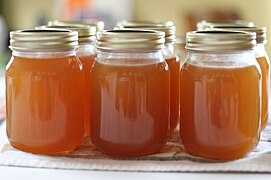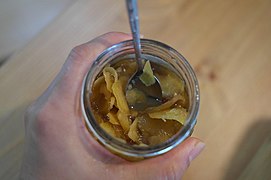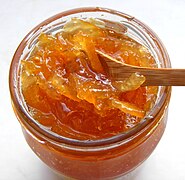Cheong (food)
 A jar ofyuja-cheong | |
| Place of origin | Korea |
|---|---|
| Associatedcuisine | Korean cuisine |
| Similar dishes | |
| Korean name | |
| Hangul | 청 |
|---|---|
| Hanja | Thanh |
| Revised Romanization | cheong |
| McCune–Reischauer | ch'ŏng |
| IPA | [tɕʰʌŋ] |
Cheong(청;Thanh) is a name for various sweetened foods in the form of syrups, marmalades, and fruit preserves. InKorean cuisine,cheongis used as a tea base, as a honey-or-sugar-substitute in cooking, as a condiment, and also as analternative medicineto treat the common cold and other minor illnesses.[1][2][3]
Originally, the wordcheong(청;Thanh) was used to refer tohoneyinKorean royal court cuisine.[4]The namejocheong(조청;Tạo thanh;"crafted honey" ) was given tomullyeot(liquid-formyeot) and other human-made honey-substitutes.[5][6]Outside the royal court, honey has been calledkkul(꿀), which is the native (non-Sino-Korean) word.[citation needed]
Varieties[edit]
- Jocheong(조청;"crafted honey" ) ormullyeot(물엿;liquidyeot):rice syrupor more recently alsocorn syrup
- Maesil-cheongorMaesilaek(매실청/매실액;"plumsyrup ")
- Mogwa-cheong(모과청;quincepreserve)
- Mucheong(무청;radishsyrup)
- Mu-kkul-cheong(무꿀청;radishand honey syrup)
- Yuja-cheong(유자청;yujamarmalade)
- Saenggang-cheong(생강청;gingermarmalade)
- Gochu-cheong(고추청;Korean green chilimarmalade)
- Maneul-cheong(마늘청;garlicpickle)
- Yangpa-cheong(양파청;onionmarmalade)
- Odi-cheong(오디청;mulberrymarmalade)
- Omija-cheong(오미자청;magnolia berrymarmalade)
- Painaepeul-cheong(파인애플청;pineapplemarmalade)
- Bae-cheong(배청;Korean pearmarmalade)
- Bae-doraji-cheong(배도라지청;Korean pearandbellflower rootmarmalade)
Maesil-cheong[edit]
Maesil-cheong(매실청;Mai thật thanh,[mɛ.ɕil.tɕʰʌŋ]), also called "plum syrup", is ananti-microbial[medical citation needed]syrup made bysugaringripeplums(Prunus mume). InKorean cuisine,maesil-cheongis used as acondimentandsugar substitute.The infusion made by mi xing water withmaesil-cheongis calledmaesil-cha(plum tea).
It can be made by simply mi xingplumsandsugartogether, and then leaving them for about 100 days.[7]To make syrup, the ratio of sugar to plum should be at least 1:1 to preventfermentation,by which the liquid may turn intomaesil-ju(plum wine).[8]Theplumscan be removed after 100 days, and the syrup can be consumed right away, or mature for a year or more.[7]
Mogwa-cheong[edit]
Mogwa-cheong(모과청[mo.ɡwa.tɕʰʌŋ]), also called "preserved quince", is acheongmade by sugaringChinese quince(Pseudocydonia sinensis). Either sugar or honey can be used to makemogwa-cheong.[9]Mogwa-cheongis used as a tea base formogwa-cha(quince tea) andmogwa-hwachae(quince punch), or as an ingredient in sauces and salad dressings.[10][11]
Yuja-cheong[edit]
Yuja-cheong(유자청;Quả bưởi thanh,[ju.dʑa.tɕʰʌŋ]), also called "yuja marmalade", is amarmalade-likecheongmade by sugaring peeled, depulped, and thinly slicedyuja(Citrus junos). It is used as a tea base foryuja-cha(yuja tea), as a honey-or-sugar-substitute in cooking, and as a condiment.[12][13][14]
Gallery[edit]
-
Jocheong(rice syrup)
-
Maesil-cheong(plum syrup)
-
Preparingmaesil-cheong
-
Mogwa-cheong(preserved quince)
-
Saenggang-cheong(preserved ginger)
-
Yuja-cheong(preserved yuja)
-
Deodeok-yujasalad, alance asiabellroot salad with ayuja-cheong-based dressing
See also[edit]
References[edit]
- ^Ro, Hyo Sun (1 February 2017)."Home cooking for Korean food: Sataejjim (slow cooker braised beef shank)".The Straits Times.Retrieved7 February2017.
- ^Baek, Jong-hyun (23 April 2016)."A taste of Korea with three regional delights".Korea JoongAng Daily.Retrieved7 February2017.
- ^배, 수빈 (10 December 2016)."[지금이 제철] 추울 때 진가 발휘하는 '청( thanh )'".MBC News Today(in Korean).Retrieved7 February2017.
- ^"cheong"청.Standard Korean Language Dictionary(in Korean).National Institute of Korean Language.Archived fromthe originalon 16 February 2017.Retrieved17 February2017.
- ^"jocheong"조청.Standard Korean Language Dictionary(in Korean).National Institute of Korean Language.Archived fromthe originalon 16 February 2017.Retrieved17 February2017.
- ^"mullyeot"물엿.Standard Korean Language Dictionary(in Korean).National Institute of Korean Language.Archived fromthe originalon 16 February 2017.Retrieved17 February2017.
- ^abBaek, Jong-hyun (23 April 2016)."A taste of Korea with three regional delights".Korea JoongAng Daily.Retrieved17 December2016.
- ^한, 동하 (1 June 2016)."청( thanh )과 발효액은 어떻게 다를까?".Kyunghyang Shinmun(in Korean).Retrieved18 December2016.
- ^김, 상현."Mogwa-cha"모과차.Encyclopedia of Korean Culture(in Korean).Academy of Korean Studies.Retrieved22 June2017.
- ^"Mogwa-cha"모과차.Doopedia(in Korean).Doosan Corporation.Retrieved22 June2017.
- ^"Mogwa-hwachae"모과화채.Korean Traditional Knowledge Portal(in Korean).Retrieved22 June2017– viaNaver.
- ^"yuja-cheong"유자청.Standard Korean Language Dictionary(in Korean).National Institute of Korean Language.Archived fromthe originalon 7 November 2017.Retrieved20 June2017.
- ^Liu, Jamie (24 October 2014)."Trend Watch: Asian Spirits and Cocktail Ingredients".Eater DC.Vox Media.Retrieved20 June2017.
- ^Joo, Judy (17 May 2016)."Citron Tea Posset".The Daily Meal.Retrieved5 January2017.
External links[edit]
 Media related toCheong (food)at Wikimedia Commons
Media related toCheong (food)at Wikimedia Commons








